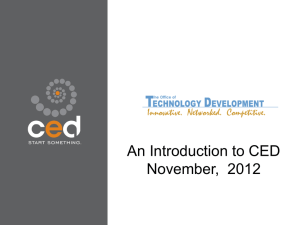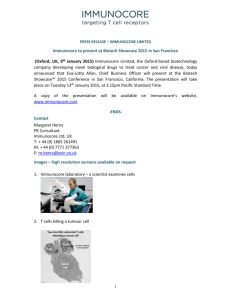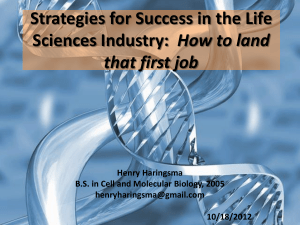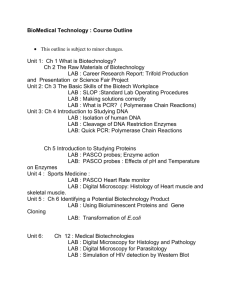leading biotech regions
advertisement
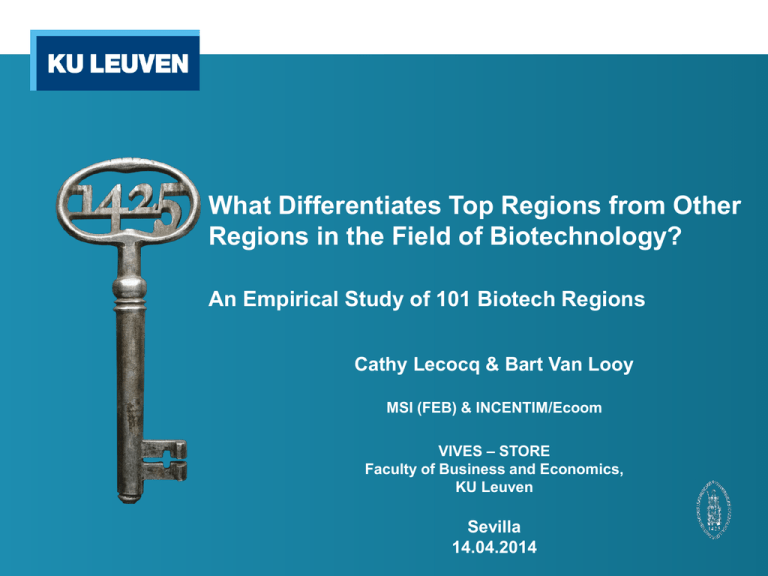
What Differentiates Top Regions from Other Regions in the Field of Biotechnology? An Empirical Study of 101 Biotech Regions Cathy Lecocq & Bart Van Looy MSI (FEB) & INCENTIM/Ecoom VIVES – STORE Faculty of Business and Economics, KU Leuven Sevilla 14.04.2014 Outline • • • • • Field of Biotech Research question Data Analyses Conclusions The Field of Modern Biotechnology Science-base technology building on some important discoveries by academic researchers in the field of molecular biology 1953: double helix structure of DNA (Univ of Cambridge, UK); 1973: recombinant DNA technique (Stanford Univ, Univ of California) From the 2nd half of the 1970’s onwards, new dedicated biotech firms were set-up to explore and commercialise the results of scientific research. Greater Boston area: > 50 spin-offs from MIT; > 50 start-ups by academic inventors By the late 1989s, large established firms entered the field by setting up strategic alliances with and/or acquiring small firms. Region of Basel: strong presence of pharmaceutical industry (Novartis, La Roche) Further technology advances rely to an important extent on interorganisational collaborations between organisations with complementary resources. Evolution of biotech patenting EPO Patents 1978-1999, worldwide RQ: Can regions develop into leading biotech regions by relying on a distributed texture (public knowledge institutes and private firms) or does the presence and/or emergence of an anchor tenant firm (Agrawal & Cockburn, 2003) becomes a prerequisite to become a ‘leading’ region? Industrial texture By their nature and core ‘raison d’être’, private firms are best placed to identify market needs, translate technological opportunities into prototypes and commercial products, and bring these new products on the market. A large firm might be a better anchor of economic success in emerging industries than an equivalent number of small firms because of their scale, extensive industry expertise and access to financial resources. • H1a: Regions in which technology development activities are to a larger extent driven by firms, are more likely to become a leading biotech region (during the growth phase). • H1b: Regions with higher levels of concentration of technology development activities within an anchor tenant firm are more likely to become a leading biotech region (during the growth phase). Entrepreneurial-oriented knowledge institutes As the field of biotech further develops, scientific knowledge is spreading on a global scale. The diffusion of knowledge is further enhanced by numerous collaborations between public knowledge institutes and private firms. Therefore, the presence of a strong local science-base and entrepreneurial-oriented knowledge institutes in the region may become less important in latter stages of the technology life cycle. • H2a: The science-intensity of a region, measured by the number of publications per population, is no longer instrumental for becoming a leading biotech region (during the growth phase). • H2b: Likewise, the entrepreneurial orientation of scientific actors, measured by their involvement in technology, is no longer instrumental for becoming a leading biotech region (during the growth phase). Biotech patent and publication data Dataset of biotech patents (1978-1999) and publications (1992-2001) Biotechnology domain study by Expertise Centre for R&D Monitoring Patents as indicators of: • • Technological performance of regions and firms Composition of the texture of regions in terms of presence of knowledge generating institutes (universities and research centres) and private firms Co-Patents as indicator of R&D collaboration Publications as indicator of the science-intensity of regions Comparable data covering regions at worldwide scale, over longer time periods and in specific technology fields Biotech regions Regions in Australia, Canada, EU-15, Japan and US Australian states (n=6) and major mainland territories (n=2), Canadian provinces (n=10) and territories (n=3), European nuts1/2 regions (n=197), Japanese prefectures (n=47), US states (n=51). Only the regions that a developed substantial amount of biotech technology activity (>=18 patents) over the time period 1992-1997 are considered in the study (n=101). The 15 regions with the highest number of patents (>= 240 patents) over the period 1992-1997 are considered as globally leading regions in biotech. Leading biotech regions (period 1992 - 1997) Rank 1 2 3 4 5 6 7 8 9 10 11 12 13 14 15 Region, country North California, US Tokyo-TO, JP Massachusetts, US South California, US New Jersey, US New York, US Maryland, US Île-de-France, FR Osaka-FU, JP Pennsylvania, US Denmark, DK Inner London, UK Illinois, US Karlsruhe, DE Nordwestschweiz, CH patents 1992-97 1,083 921 824 711 650 626 576 563 477 449 376 328 305 288 280 Together, the 15 leading biotech regions account for 56% of all biotech patent activity Leading Biotech Regions The technological performance of regions and the share of biotech technology development activities undertaken by private firms (period 1992-1997) Region, country a North California, US b Massachusetts, US c South California, US d New York, US e Maryland, US f Île-de-France, FR g Pennsylvania, US h Inner London, UK I Tokyo-TO, JP j New Jersey, US k Osaka-FU, JP l Denmark, DK m Illinois, US n Karlsruhe, DE 0 Nordwestschweiz, CH “Distributed” versus “Concentrated” regions Top “distributed’ regions (n=8) 0,58 23,7 0,28 0,31 Top “concentrated” regions (n=7) 0,89 20,3 0,42 0,24 z-test -7,833 2,368 -2,387 2,564 *** ** ** ** knowledge institutes International collaboration with 0,014 0,004 7,177 *** knowledge institutes International collaboration with firms 0,65 0,88 1,38 0,95 -1,936 -0,585 * Share of company patents Number of firms Company concentration index Science-intensity of the region Entrepreneurial orientation of What differentiates leading regions? Random effect logit models (period 1992-97, panel) Dependent variable: top 15 region in year t (dummy) P(yit = 1 / xit) with t = 1-6, xit contains the explanatory and the control variables Logit models All Regions Regions with distributed texture Regions with concentrated texture 17.56** 86.18*** 52.39*** (7.89) (25.07) (17.34) 0.69*** 2.17** 0.92** (0.18) (0.87) (0.41) 6.14** -22.77 25.34*** (3.02) (23.41) (9.56) 201.14** 1479.37*** 504.07 (102.21) (557.68) (329.23) 1.28** 3.36 4.32*** (0.60) (5.24) (1.25) -0.41 -1.98 -0.31 (0.57) (3.08) (0.99) 0.0005 0.0007 0.0032*** (0.0003) (0.0006) (0.0012) -0.23 14.24* -6.07 (1.96) (7.57) (6.38) -0.78*** -0.87 -2.52*** (0.29) (1.16) (0.76) -19.06*** -75.49*** -51.66*** (5.03) (18.35) (10.34) Observations 606 384 222 Loglikelihood -525.07 -9.86 -27.23 P 0.0086 0.0021 0.0004 Dependent: Top 15 region in year t Science-intensity of the region Number of firms Company concentration index Entrepreneurial orientation of knowledge institutes International collaboration with knowledge institutes International collaboration with firms Population US dummy Time Constant Conclusions Based on a systematic, quantitative analysis of texture characteristics of 101 biotech regions worldwide for the period 1992-1997, we find evidence for: the existence of 2 types of regions with different texture characteristics: distributed and concentrated regions. Both type of regions can become a leading region: regional technology development activities do not need to be primarily driven by private firms. Leading regions build on a strong science base and are characterised by the presence of growing industrial activities in the field of biotechnology Concentrated regions benefit from the concentration of biotech activities within an leading, “anchor-tenant” firm. Distributed regions benefit from the entrepreneurial orientation of their knowledge institutes. Thank you! Contact: bart.vanlooy@kuleuven.be
